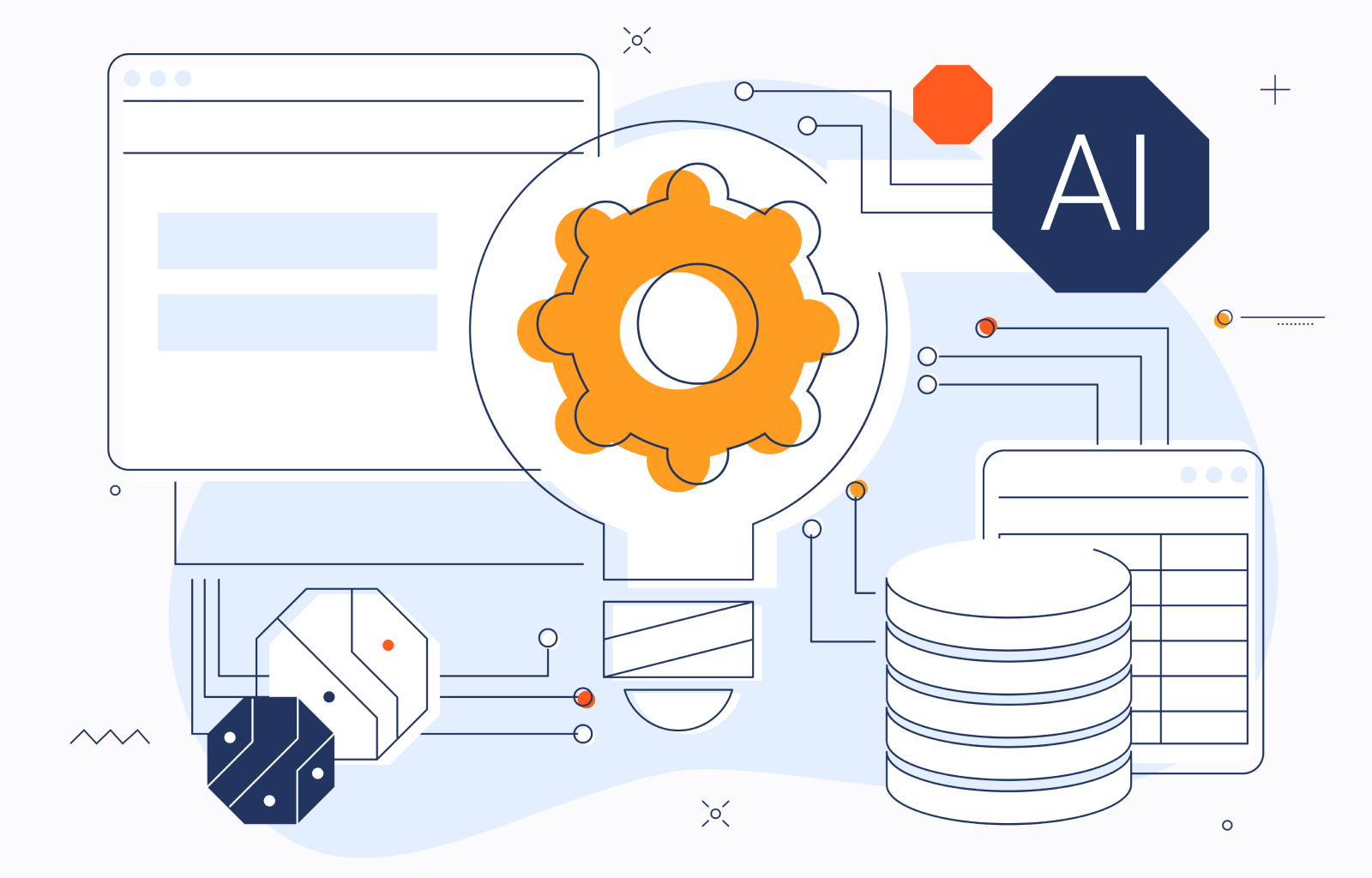Beyond APIs: Why Middleware Matters More in the Age of Generative AI?

APIs have been and continue to be the backbone of AI integrations thus far. They’ve democratized access to models, allowing developers to add AI features with a few lines of code.
Yet, when generative AI became huge in the 2020s, especially with the arrival of ChatGPT in 2022, the cracks in the API-centric approach started to show. Unlike other models, gen AI doesn’t just retrieve information. It creates, adapts, and interacts in ways that demand more flexibility, scalability, and security than APIs can deliver.
This is where middleware in generative AI is necessary. In this post, we’ll discuss why it matters more than APIs and how exactly you can use it in modern gen AI projects.
APIs Alone Aren’t Enough Anymore
APIs are the standard way for connecting software systems, whether it’s fetching product data from a database or processing a payment through a third-party gateway.
When artificial intelligence gained prominence, APIs became the primary method for connecting to the model. And they still are. According to Gartner, over 80% of surveyed companies will have used gen AI APIs or deployed gen AI apps by 2026. The reason for this popularity? The sheer simplicity of the integration process: a dev gets a standardized way to send a request and get a response.
However, more and more limitations of APIs for generative AI integration pop up. Most common ones include:
- Rate limits that degrade performance just when workloads spike.
- Authentication and security gaps that create vulnerabilities across sensitive data pipelines.
- Scaling difficulties when demand grows beyond what an API can reliably support.
- Complex data management as multiple data sources must be transformed, synchronized, and governed.
- Lack of orchestration since APIs connect tools, but don’t manage how they work together.
Take a simple example: you want to integrate GPT with your company’s internal knowledge base and a third-party CRM. With APIs alone, you’d need custom scripts and constant monitoring to ensure reliable data flow. One failure, say a rate limit, and the entire workflow breaks. Middleware solves this by working as an intermediate layer between systems.
What Is AI Middleware and What It Actually Does
Middleware is the invisible layer of software that provides one or more types of communication between different systems, such as apps, databases, and third-party services. It’s also commonly referred to as “software glue” or “glue code.”
Middleware in generative AI works similarly to how it does in the general software domain. Unlike APIs, which are a one-to-one connection for a specific task, AI middleware is a central hub that combines all models, tools, and sources in one place.
Key middleware features include:
- Orchestration. Coordinates how multiple AI models, databases, and services interact.
- Translation between models and tools. Normalizes different data formats and protocols to make sure that outputs from one system can be easily used by another.
- Context persistence. “Remembers” past conversations, user prompts, and relevant history across sessions to make sure each new prompt builds on the last one.
- Security and monitoring. Enforces authentication such as OAuth2 or token-based authorization, data masking, logging, and compliance auditing.
- Workflow automation. Automates the entire process, from data fetching to output formatting.
Consider this example. If you want to run a RAG pipeline across multiple LLMs and databases, doing this solely with APIs is far from convenient. You’ll likely have to juggle different authentication flows, deal with inconsistent outputs, and write custom code to stitch everything together. Using middleware, in turn, you define the workflow once and let the middleware handle the rest.
Where Middleware Really Adds Value in Generative AI Projects
While an API might be enough for a simple gen AI workflow, middleware shines in more complex scenarios. The most common ones are:
- Large enterprises with complex data flows. Larger organizations typically deal with larger amounts of data. CRMs, ERPs, internal databases, custom apps, and cloud services all have datasets that need to be connected. Middleware is a suitable approach for orchestrating this heterogeneity.
- Multi-vendor and multi-model strategies. More companies are turning to a multi-model approach, which protects them from vendor lock-in, cost overruns, and performance issues. And middleware is perfect for making this happen. It allows for combining different models for different tasks and routes requests to the most appropriate model every time.
- Industries with strong governance or security needs. Finance, healthcare, defence, and other critical sectors cannot afford data breaches. Middleware takes all the worries away by providing a convenient means for enforcing policies and security across every model and workflow.
- Streamlining prototyping into production. Moving from a prototype to a production app isn’t simple with a single API. Using middleware, instead, lets teams take experimental pipelines and deploy them as stable, production-grade workflows.
- Scaling LLMs across teams and use cases. When gen AI adoption in a company grows, one team’s chatbot becomes another team’s analytics assistant. AI infrastructure middleware is sufficient for all sorts of prompts and contexts.
When to Consider Middleware (Build vs. Buy)
By now, you know which kinds of gen AI projects benefit most from middleware. But how do you make sure your own project needs it? And what to choose in this APIs vs middleware debate? Let’s go through some tips.
Signs Your System Is Outgrowing Basic API Calls
The main sign: your development team spends more time on integration than on core product features. Other indicators include:
- Frequent errors or downtime from dealing with multiple integrations.
- Struggles to manage rate limits and authentication at scale.
- Growing complexity in orchestrating workflows across models and tools.
- Security or compliance concerns around sensitive data pipelines.
- Unpredictable costs and no easy way to optimize token usage.
Middleware Platforms vs. Custom Logic: What’s Better When
Once you decide you definitely need middleware, there are two options: use a ready-made platform or build your own.
- Platforms. Faster to deploy, built-in orchestration, monitoring, and security; best for projects that need to scale quickly without reinventing the wheel.
- Custom logic. More flexibility and control; best for projects that have highly unique workflows or specialized compliance requirements.
How Startups and Enterprises Approach This Differently
The choice between building or buying often comes down to a company’s size, resources available, and timelines set.
- Startups. May initially build a custom MVP for experimentation. But as they grow, the operational overhead often pushes them toward a pre-built platform.
- Enterprises. More likely to use pre-built platforms for their security, compliance, and stability, and extend them with custom development.
Conclusion
Gen AI is rewriting the rules of integration. While it still relies on APIs for simple workflows, middleware is the future. It connects fragmented ecosystems with a universal language, takes care of security and compliance, and adds orchestration that APIs lack.
If you’re thinking about using middleware in generative AI, our AI staff augmentation services provide the right expertise for that. Let’s move on from experimentation to real-world workflows together.
FAQ
AI middleware is software that sits between and connects different AI models, data sources, and enterprise systems. It’s commonly referred to as “software glue.” Unlike APIs, which pass requests and responses between two apps, middleware creates a unified workflow for all systems. It also adds orchestration, security, context management, and data normalization for diverse models and tools. Owing to these attributes, it makes it possible to achieve scalability in AI systems, integrate multiple models, and stay compliant.
Small generative AI projects, such as testing a chatbot with one API or validating a proof of concept, may not initially require middleware. A direct API connection would usually be sufficient. But when the projects grow, so does the number of data sources and the need for stricter security. In such cases, middleware in generative AI becomes necessary.
Numerous platforms offer middleware for integrating and orchestrating generative AI. Examples are Watsonx Orchestrate on AWS, Workato iPaaS for AI workflows, Microsoft Azure’s orchestration and AI tools, and the LangChain framework for LLM integration.
AI middleware enhances cross-model orchestration by intelligently managing the interaction between different LLMs and tools within a single workflow. It analyzes a user’s request and automatically routes it to the most suitable model. Basically, middleware works as a coordination layer in an enterprise AI architecture.
Contact us

